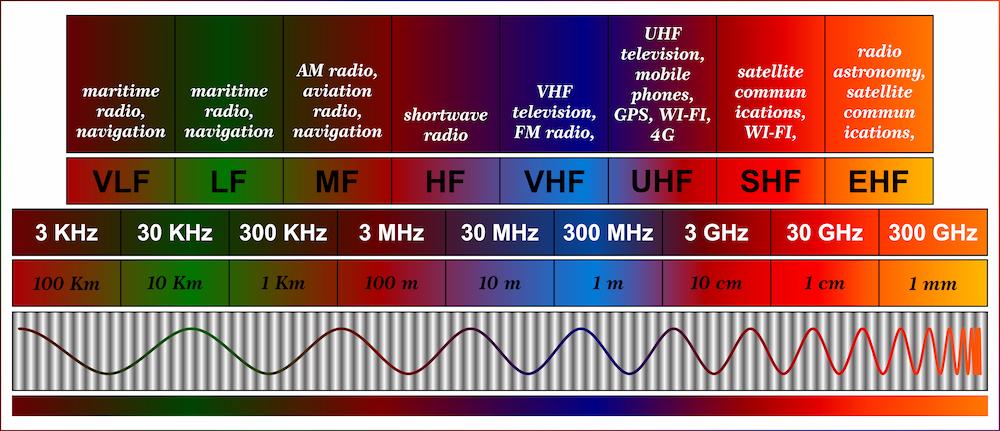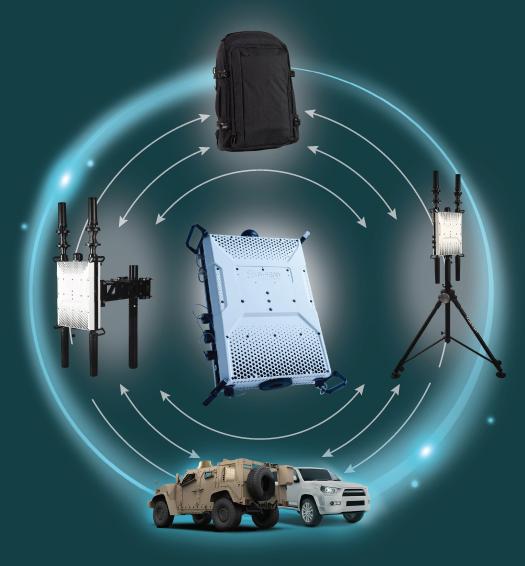Uncrewed aircraft system (UAS) technology continues to iterate at an unprecedented rate of change. Both commercial and custom-made UAS operate across various, changing, and sometimes multiple, radio frequencies (RF). This poses challenges for systems designed to detect and neutralize unauthorized drone activity. As such, the ability to identify drones in a wide, and ever-changing, range of RF bands has become a critical aspect of maintaining security and safety. This article delves into the evolving frequencies used by drones globally and the necessity for RF-cyber C-UAS systems to readily support these frequencies.
Radio Frequency 101 for UAS
Radio Frequency (RF) refers to the portion of the electromagnetic spectrum ranging from approximately 3 kHz to 300 GHz, used for wireless communication and broadcasting. In the context of drones, RF technology is crucial for video, telemetry and control (C2) transmissions. It enables UAS to receive commands from Remote Controllers (RC) and ground control stations (GCS) and transmit video signals and telemetry information such as location and sensor readings. In short, RF provides the backbone of UAS communications.
UAS utilize RF signals to maintain a stable connection between the drone and its GCS. Commonly used frequency bands for drone communication include the unlicensed and globally available 2.4 GHz and 5.8 GHz bands. Other technologies, such as Wi-Fi and Bluetooth, share these bands. This can lead to potential interference in crowded environments. To mitigate interference, drones often may employ RF-based techniques such as frequency hopping and spread spectrum technologies.
For mission-critical and commercial applications, UAS may operate on licensed frequency bands, such as the L-band (1-2 GHz) or the C-band (4-8 GHz), which offer higher reliability and reduced interference.
The choice of frequency band will vary based on the UAS’ intended use and other requirements. Lower frequencies, for example, offer better penetration and longer range but may require larger antennas and RF components. Higher frequencies provide shorter range but also require smaller-size antennas and RF components..
Trends in UAS Radio Frequencies

The need for better performance, reduced interference, and compliance with varying regulations across different regions has driven diversification in frequency usage, the use of lower frequency bands and multi-band systems.
Diversification in UAS Radio Frequencies
Increasingly, UAS from leading vendors, such as DJI and Autel, utilize multiple frequency bands to ensure reliable communication and control (C2). While commonly used bands include 2.4 GHz and 5.8 GHz, newer models incorporate additional frequencies such as 5.2 GHz, 868 MHz and 915 MHz.
Unique RF For Custom-Made DIY Drones
Custom-made or DIY/FPV UAS pose a unique and significant threat due to their ability to operate on less common frequency bands. These UAS, often used for malicious purposes such as terror attacks, can operate on frequencies like 433 MHz, 868 MHz and 915 MHz.
Evolution Towards Multi-Band Frequencies
In addition to the diverse RF bands, including low-frequency ones, UAS technology also continues to move towards the use of multi-band frequencies. The need for enhanced reliability, better signal penetration through obstacles and improved resistance to interference have all influenced this evolution. As commercial UAS vendors continue to innovate, in the future they will more likely incorporate additional new frequency bands into their systems.
RF-Cyber C-UAS Systems Must Support Full RF Range
RF-cyber C-UAS systems play a key role in any multi-layered defense solution to detect and neutralize unauthorized UAS activity. These advanced technologies, designed to counter the growing threat of UAS, leverage RF signals to detect, locate and identify unauthorized UAS through their unique communication protocols which allow for precise tracking and threat assessment.

Unlike traditional methods that often rely on jamming or kinetic solutions, RF-cyber systems can take control of rogue UAS and safely guide them to a predetermined landing zone without causing collateral damage or disrupting other communication signals. This approach ensures operational continuity and safety in sensitive environments such as airports, stadiums, and urban centers. The ability of RF-cyber systems to distinguish between authorized and unauthorized UAS further enhances their effectiveness and ensures that legitimate operations remain unaffected.
To remain relevant, and be able to detect, track, identify, and mitigate a wide range of potentially dangerous drones, these systems must support the full frequency range used by UAS, from 400 MHz to 6 GHz, and not only the more common 2.4 and 5.8 GHz frequency bands, without requiring hardware modifications. This flexibility ensures that systems can not only address the diverse multiverse of frequencies in use today but will also quickly adapt to new frequency bands as they become introduced. The ability to flex without hardware changes allows for seamless updates and ensures that the C-UAS system can remain operational across different environments and scenarios, without having to take it out of action.
D-Fend Solutions has approached this issue by making sure that its core EnforceAir RF-Cyber C-UAS system provides support for old, new, and notably, less common frequency band coverage, and without requiring the end-user operator to implement any hardware modifications or changes. The commitment to this coverage is based on constant feedback from customers deploying the system in the most challenging military conflict zones and sensitive civilian environments.
The importance of RF-Cyber C-UAS support for complete frequency band coverage cannot be overstated. As drones continue to evolve and operate across a broader spectrum of frequencies, the ability to detect and respond effectively will remain paramount. By supporting the full range of frequencies without hardware modifications, RF-cyber C-UAS systems can support a robust defense against both commercial and custom-made UAS to ensure safety and security in an increasingly complex environment across global skies.

